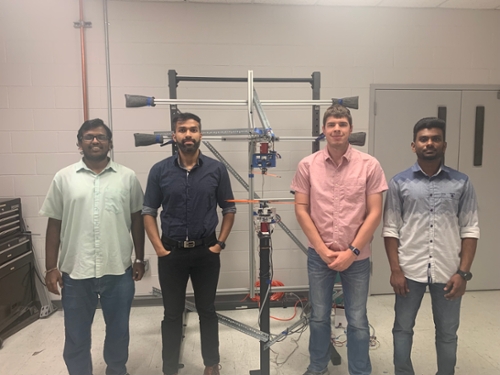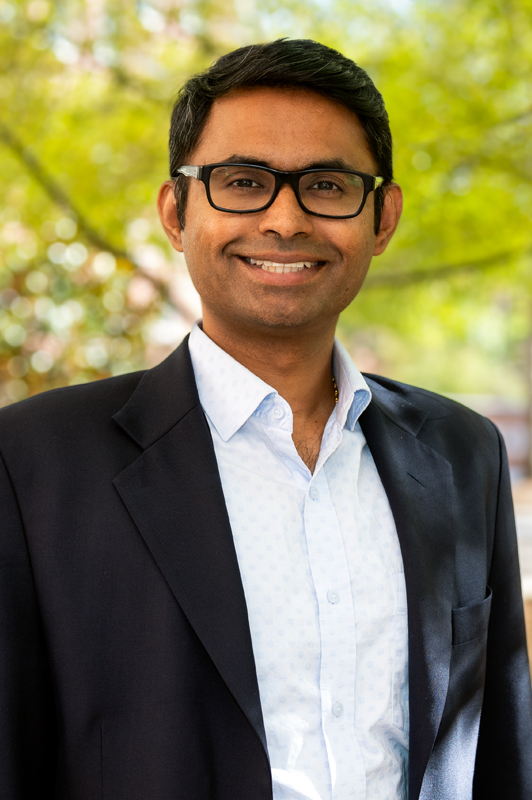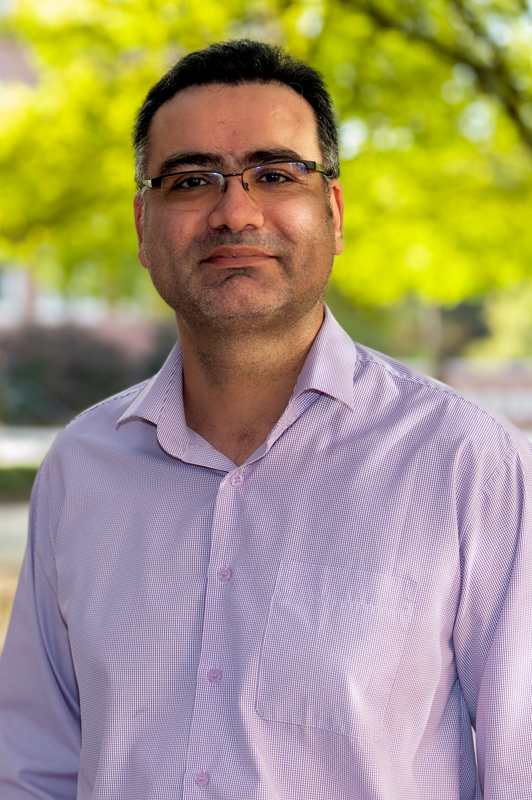Researchers earn multi-year VLRCOE grant to study coaxial rotor phenomena
Published: Apr 17, 2023 7:35 AM
By Joe McAdory
Helicopters when operated close to the ground not only generate a flurry of blinding dust and turbulent outwash, making the operating environment complex, but also impact the vehicle’s performance. To ensure the safety of these vehicles, a proper understanding of these modifications is paramount.
Two assistant professors in aerospace engineering, Vrishank Raghav and Ehsan Taheri, and graduate student Lokesh Silwal, developed a proposal that will make strides to understand these complex flow phenomena.
In a recent study, “Aerodynamic Interactions of Counter-Rotating Coaxial Rotors Hovering in Ground Effect,” published in December 2022 by the Journal of Aircraft, Raghav and Silwal helps to understand the performance modifications in presence of ground. To understand the flow environment by implementing Taheri’s proposed control algorithm, the team received multi-year funding under the Vertical Lift Research Center of Excellence (VLRCOE) program, which is jointly funded by the U.S. Army, Navy, and NASA, and combines innovative research with collaboration across government, industry and academia to train the next generation of aviation scientists and engineers.

“These honors are typically reserved for cutting-edge fundamental research and receiving them is an acknowledgement of our subject matter and hard work as a team here at Auburn University,” said Raghav, who was once funded by the VLRCOE program as a graduate student at Georgia Tech. “An award from the VLRCOE is an outstanding achievement in one’s career and it recognizes the researcher’s effort toward pushing the boundaries of vertical flight.”
Raghav is a 2022 National Science Foundation CAREER Award recipient who directs the university’s Applied Fluids Research Group. Taheri, director of the Aero-Astro Computational Laboratory, also serves as an associate editor of the Journal of Optimization Theory and Applications. Silwal, past president of Auburn University’s Vertical Flight Society (VFS), was among the Redstone VFS chapter’s scholarship recipients in 2022.
Raghav noted the study was kick-started from a series of discussions to better understand the complex rotor-rotor and rotor-ground interactions between himself and Silwal.
“Lokesh conducted preliminary experiments to study the performance characteristics of counter-rotating coaxial rotors near the ground,” Raghav said. “Dr. Taheri and his Ph.D. student, Praveen Jawaharlal Ayyanathan made crucial contributions to the project as they developed control strategies to synchronize the phase between the individual rotors in counter-rotating coaxial rotor configurations. This rotor phase synchronization, coupled with flow diagnostic techniques, will enable a comprehensive understanding of the effects of blade passage on the performance of outwash characteristics.”
With the renewed interest in counter-rotating coaxial rotor (CCR) vehicles, a comprehensive understanding of its performances under out-of-ground effect and in-ground effect (IGE) operating conditions was necessary. This team’s research reports on an experimental study of a modular CCR system during IGE hovering conditions.
“Our preliminary work on the load measurements of coaxial rotors shows that near the ground, the overall performance of coaxial rotors behaves similarly to the single-rotor helicopter,” Raghav said. “However, upper and lower rotors’ performance show an intriguing phenomenon. The individual rotor data showed that the effects of the ground were much more pronounced for the lower rotor than the upper rotor. The lower rotor also showed a significant increase in thrust farther from the ground than the upper rotor – even after accounting for its relative proximity due to rotor separation.
“This work shows competing rotor-rotor and rotor-ground aerodynamic interactions that alter the coaxial rotors’ operating environment, which was previously unknown.”
The VLRCOE award will help chip away at longstanding scientific barriers and help unravel some of these mysteries and improve the understanding of fundamental flow physics. “Preliminary load measurements provide an insight into the rotor operating environment and how the ground affects the rotor,” Raghav said. “However, it provides an understanding of the flow development along the ground plane and the rotor’s impact on its surrounding environment. It needs further attention through flow quantification techniques.
“The presence of one rotor above the other now introduces more complexity in the operating environment. One such phenomenon is the blade passage event, where one rotor’s blade passes above another’s. This effect on the performance and flow beneath the rotors is yet to be understood. It requires electronic synchronization of mechanically uncoupled rotors to comprehend the flow physics of this configuration.”
Media Contact: , jem0040@auburn.edu, 334.844.3447
Vrishank Raghav, assistant professor in aerospace engineering (left), Lokesh Silwal, graduate student in aerospace engineering (center), and Ehsan Taheri, assistant professor in aerospace engineering, with their coaxial rotor prototype.



